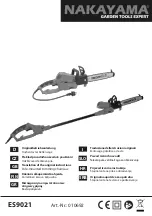
6
7
POWER CONNECTIONS
FEATURES
This tool has a precision-built electric motor. It should be connected to a POWER SUPPLY THAT IS 120 VOLTS, 60 HZ,
AC ONLY (NORMAL HOUSEHOLD CURRENT). Do not operate this tool on direct current (DC). A substantial voltage
drop will cause a loss of power and the motor will overheat. If the tool does not operate when plugged into an outlet,
double-check the power supply.
To reduce the risk of electric shock, this equipment has a polarized plug (one blade is wider than the other). This plug will
fit in a polarized plug only one way. If the plug does not fully fit in the outlet reverse the plug. If it still does not fit, contact
a qualified electrician to install the proper outlet. Do not change the plug in any way.
When using a power tool at a considerable distance from a power source, be sure to use an extension cord that has
the capacity to handle the current the tool will draw. An undersized cord will cause a drop in line voltage, resulting in
overheating and loss of power. Use the chart to determine the minimum wire size required in an extension cord. Only
round jacketed cords listed by Underwriter’s Laboratories (UL) should be used. When working outdoors with a tool, use
an extension cord that is designed for outside use. This type of cord is designated with a “WA” on the cord’s jacket.
Before using any extension cord, inspect it for loose or
exposed wires and cut or worn insulation.
Cutting Capacity
(Maximum nominal
lumber sizes)
0° Miter/0° Bevel: 4” x 12”
45° Miter/ 0° Bevel: 4” x 8”
0° Miter/45° Bevel: 2” x 12”
45° Miter/45° Bevel: 2” x 8”
Net Weight
29.5 lbs
Input
120 V~, 60hz, 15 Amps
Blade Arbor
5/8”
Blade Diameter
10”
No Load Speed
5,500 r/min (RPM)
** Ampere rating (on total data label)
12A- 16A
Cord Length
Wire Size
25’
14 AWG
50’
12 AWG
** Used on 12 gauge - 20 amp0 circuit
NOTE: AWG = American Wire Gauge
ELECTRICAL CONNECTION
PRODUCT SPECIFICATIONS
POLARIZED PLUGS
EXTENSION CORDS
Keep the extension cord clear of the
work area. Position the cord so that it
will not get caught on lumber, tools or other
obstructions while you are working with a power tool.
Failure to do so can result in serious personal injury.
Check extension cords before each use. If damaged
replace immediately. Never use tool with a damaged
cord, since touching the damaged area could cause
electrical shock resulting in serious injury.
Summary of Contents for S26-261L
Page 69: ...69 NOTES REMARQUES NOTAS ...







































